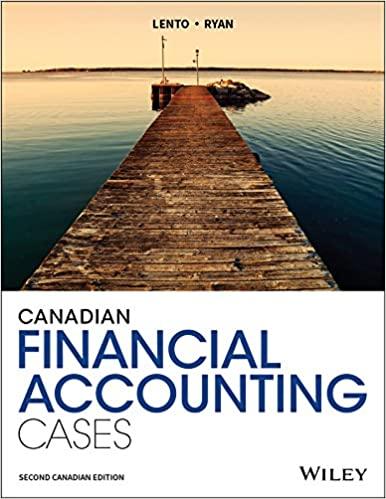Sandwich Hut (SH) is a deli that sells fresh subs, soups, and salads. Fresh Subs was founded
Question:
Sandwich Hut (SH) is a deli that sells fresh subs, soups, and salads. Fresh Subs was founded by Jenny and Jason, who are brother and sister, and began as a small, local deli in Edmonton. Based on rave reviews of their subs, Jenny and Jason have decided to expand operations within Alberta. As part of the expansion plans, all of the assets were rolled over into a newly formed corporation that has a fiscal year end of December 31, 2017. The corporation issued 50,000 shares to each of Jenny and Jason for $3 per share. Upon incorporation, SH also received a 10-year, 9%, $250,000 loan with annual payments from the First Bank of Edmonton to help finance the expansion.
During their fi rst year of operations, Jenny and Jason decided to hire Lebeau and Liang LLP (L&L) to help develop accounting policies that are consistent with ASPE for various new transactions. You, a senior accountant with L&L, have been assigned to the SH file and met with Jenny and Jason to discuss the various new issues. Jenny and Jason have provided you with the following information regarding the new issues:
1.
SH implemented a customer loyalty program at the beginning of the year. Each customer receives 1 Sub Club point for every large sub that they purchase. A customer receives a free large sub once they earn 10 Sub Club points. A large sub sells for an average of $5 and costs an average of $3 toproduce. As of year end, a total of 23,500 Sub Club points were issued. Jenny and Jason did not know how to account for this program and stated that they will record the expense of the free sub when a customer redeems their points. Fixed costs are approximately 30% of gross margin.
2.
To help finance their expansion across Alberta, SH issued 10,000 preferred shares to a group of private investors for $10 per share. The preferred shares carry a 10% annual, cumulative dividend yield and are redeemable by SH. The dividend rate was issued at such a high level because SH does not have access to any other sources of capital in the current year. In five years, the dividend is expected to double. Given that they are preferred shares and not retractable, Jenny and Jason recorded these shares as equity.
3.
Given the volatility of commodity prices, SH has entered into a forward contract with the First Bank of Edmonton. On April 1, SH has locked the price of 100,000 kg of wheat at $0.75/kg. Upon its inception, SH did not have to put forth any cash. All cash transfers will take place on settlement. As at December 31, the price of wheat is trading on the Chicago Board of Trade at $0.87/kg. Jenny and Jason have made no entries at year end and will record the cost of goods sold with a wheat price of $0.75 in the next fi scal year.
4.
On August 1, the company reacquired and cancelled 1,500 of Jenny’s and 1,500 of Jason’s shares at $4 per share. All 3,000 shares were re-issued to Khaled, a long-time friend, at a price of $5 per share. Jenny and Jason were unsure of how to account for these transactions.
5.
On January 1, SH purchased a new roaster oven. The purchase was financed though an “interestfree” five-year vendor loan, whereby SH is required to pay back $5,000 in each year. Jenny and Jason are excited about this financing promotion because they would have to pay 9% interest to borrow the money from the bank. Jason and Jenny recorded an asset and liability at $25,000. At year end, the $5,000 cash payment was recorded as a reduction of the long-term liability. SH uses the straight-line method to depreciate the asset, which has a seven-year useful life.
To protect its investment, the First Bank of Edmonton has included a restrictive covenant whereby SH cannot have a debt to equity ratio in excess of 1:1. Upon inception, the debt to equity ratio is 0.83:1. Both Jenny and Jason have expressed their pleasure with the debt to equity ratio.
The partner has asked that you prepare a report that helps Jason and Jenny understand the implications, if any, of the debt-to-equity covenant at year end. The partner reminds you that it may be ideal to start by first analyzing the accounting issues.
Required Prepare the report.
Step by Step Answer:

Canadian Financial Accounting Cases
ISBN: 9781119277927
2nd Canadian Edition
Authors: Camillo Lento, Jo Anne Ryan






